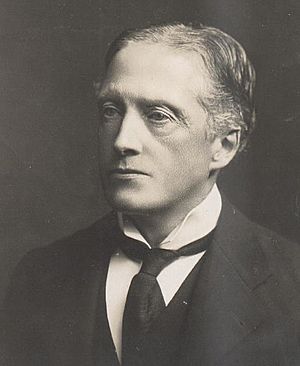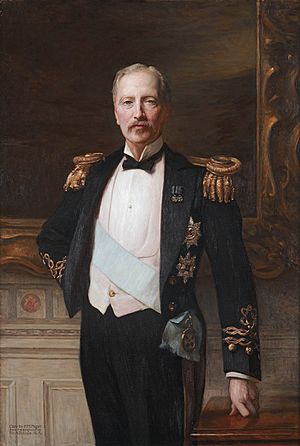Edward Guinness, 1st Earl of Iveagh facts for kids
Quick facts for kids
The Earl of Iveagh
|
|
|---|---|

The 1st Earl of Iveagh
|
|
| Born |
Edward Cecil Guinness
10 November 1847 Clontarf, Dublin, Ireland
|
| Died | 7 October 1927 (aged 79) Grosvenor Place, London, England
|
| Resting place | Elveden, Suffolk |
| Education | Trinity College Dublin |
| Political party | Irish Unionist Alliance |
| Spouse(s) | Adelaide Guinness |
| Children | Rupert Guinness, 2nd Earl of Iveagh Ernest Guinness Walter Guinness, 1st Baron Moyne |
| Parent(s) | Benjamin Guinness, 1st Baronet Elizabeth Guinness |
| Family | Guinness |
Edward Cecil Guinness, 1st Earl of Iveagh (1847–1927) was a very successful Irish businessman and a kind person who helped many. He was part of the famous Guinness family, known for their brewing business. Edward became the head of the company and was the richest man in Ireland during his time. He is remembered for giving a lot of money to build affordable homes in London and Dublin for people who needed them.
Contents
A Life of Service and Success
Edward Guinness was born in Clontarf, Dublin, Ireland. He was the third son of Sir Benjamin Guinness, who was also a successful businessman. Edward studied at Trinity College Dublin and graduated in 1870.
Early Public Roles
Edward took on important roles in public life. In 1876, he served as the Sheriff of Dublin. Nine years later, he became the High Sheriff of Dublin City. In the same year, he was given the special title of "baronet" for helping with a visit from the Prince of Wales to Ireland.
Becoming a Lord
In 1891, Edward Guinness was given the title Baron Iveagh. This meant he became a member of the House of Lords, a part of the British Parliament. He was also made a Knight of St Patrick in 1895. Later, in 1905, he became Viscount Iveagh. In 1919, he received his highest title, Earl of Iveagh.
Supporting Education
Edward was also involved in education. He was elected as the Chancellor of the University of Dublin in 1908 and held this important position until 1927. He also served as a vice-president of the Royal Dublin Society.
Leading the Guinness Business
Edward Cecil Guinness took over the family's brewing business after his father passed away in 1868. He was the managing director until 1889. Under his leadership, the Guinness brewery became the largest in the world. It covered a huge area of about 64 acres.
Growing the Brewery
In 1876, Edward bought out his older brother's share of the Dublin brewery for a large sum of money. Over the next 10 years, he made the brewery incredibly successful. The value of the business grew enormously. By 1879, the brewery was making 565,000 "hogsheads" of stout (a large barrel of beer). Just seven years later, in 1886, they were selling over 900,000 hogsheads each year.
Becoming Ireland's Richest Man
In 1886, Edward made a big decision. He sold two-thirds of the company on the London Stock Exchange for £6 million. This was a huge amount of money at the time, making him the richest man in Ireland. He then retired as a multi-millionaire at the age of 40. Even after retiring, he remained the chairman of the company and its biggest shareholder. By 1914, the brewery's production had doubled again.
Guinness Storehouse
In 1902, he ordered the building of the Guinness Storehouse. Today, this building is one of Ireland's most popular tourist attractions.
Helping Communities with Housing
Like his father and brother, Lord Iveagh was very generous. He gave almost £1 million to help improve living conditions and build homes for people.
Housing in London and Dublin
In London, he started the 'Guinness Trust' in 1890. This trust still manages over 66,000 homes today. In Dublin, the Guinness Trust became the Iveagh Trust in 1903. This trust helped fund the largest urban renewal project in Dublin at that time. It still provides more than 10% of the social housing in central Dublin.
Creating Public Parks
Edward also gave the large back garden of his house in central Dublin, known as the "Iveagh Gardens", to the new University College Dublin in 1908. This beautiful garden is now a public park. Before this, he had bought and cleaned up some crowded areas near St Patrick's Cathedral, Dublin. In 1901, he created the public park known as "St. Patrick's Park". He also built the Iveagh Market nearby, so street traders could sell their goods indoors.
Supporting Science and Medicine
Lord Iveagh also supported medical and scientific research. In 1898, he gave £250,000 to the Lister Institute. This was the first medical research charity in the United Kingdom, focusing on studying infectious diseases. In 1908, he helped fund the Radium Institute in London.
He also supported new buildings for physics and botany at Trinity College Dublin in 1903. He helped pay for a student residence there in 1908.
Antarctic Exploration
Edward Iveagh also helped pay for the British Antarctic Expedition, 1907–09. This was a journey to explore the South Pole. A mountain in Antarctica, called Mount Iveagh, is named after him because of his support.
Collecting Art
Edward Cecil Guinness loved fine art throughout his life. From the 1870s, he collected many valuable Old Master paintings, old furniture, and historic textiles.
His Art Collection
He started building his art collection seriously after he retired and was furnishing his London home. After his death in 1927, much of his painting collection was given to the nation. These artworks are now displayed at the Iveagh Bequest at Kenwood House in north London. His home in Dublin, Farmleigh, also shows his excellent taste in architecture, furniture, and textiles.
Political Views
Edward's father and brother were involved in politics as Conservative Members of Parliament. Edward chose to be less involved in direct politics. He preferred to make social improvements himself.
Supporting Unionism
He supported the Irish Unionist Alliance. This group wanted Ireland to remain part of the United Kingdom. In 1913, during a big workers' strike in Dublin, he refused to lock out his own employees. He also took part in a meeting in 1917-18 that tried to find a peaceful solution for Irish demands for more self-governance.
He was friends with W. T. Cosgrave, who later became the first leader of the Irish Free State in 1922. Edward, like many other business people, worried that Irish self-governance might lead to new taxes between Dublin and Britain, which was his biggest market.
Sporting Hobbies
Edward Iveagh enjoyed sports and hobbies.
Coaching and Yachting
One of his favorite hobbies was driving a coach pulled by four horses. This was a very active hobby. He would sometimes drive his coach from Dublin to the Punchestown Racecourse, about 20 miles away, and back. He was also a keen yachtsman, meaning he loved sailing boats. In 1897, he won a race between England and Kiel that was sponsored by Kaiser Wilhelm. He owned a large schooner (a type of sailing ship) called "Cetonia" and often took part in Cowes Week, a famous sailing event.
His Legacy
Edward Cecil Guinness passed away in 1927 in London and was buried in Elveden, Suffolk. His estate (all his wealth) was valued at a very large sum of money. This was a record in Britain until 1933.
Gifts to the Nation
In his will, he gave Kenwood House in Hampstead to the nation. This house became a museum for his art collection, known as the "Iveagh Bequest". In 1936, his family placed a special stained-glass window, called the "Iveagh Window", in St Patrick's Cathedral, Dublin to remember him.
In 1939, Edward's sons gave his Dublin home at 80 St. Stephen's Green to the new Irish Free State. This building was renamed Iveagh House. Since then, it has been the home of the Department of Foreign Affairs, and "Iveagh House" is now another name for the department itself.
Family Life
Edward Cecil Guinness married his cousin, Adelaide Guinness, in 1873. She was often called "Dodo". They had three sons:
- Rupert Guinness, 2nd Earl of Iveagh (1874–1967)
- The Hon. Arthur Ernest Guinness (1876–1949)
- Walter Guinness, 1st Baron Moyne (1880–1944)
See also
- Farmleigh
- Guinness family


